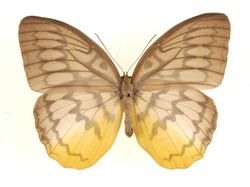Biology:Melanocyma
| Pallid faun | |
|---|---|

| |

| |
| Scientific classification | |
| Kingdom: | |
| Phylum: | |
| Class: | |
| Order: | |
| Family: | |
| Subfamily: | |
| Tribe: | |
| Genus: | Melanocyma Westwood, 1858
|
| Species: | M. faunula
|
| Binomial name | |
| Melanocyma faunula (Westwood, 1850)
| |
Melanocyma is a monotypic butterfly genus in the subfamily Morphinae of the family Nymphalidae. Its one species Melanocyma faunula, the pallid faun, is restricted to Burma, Malaya, Thailand and Indochina in the Indomalayan realm.[1]
The wingspan of M. faunula is at around 90 millimetres.[2] Individuals found in lowland forests are often smaller than specimens of M. faunula found on hills.[3]
There are two subspecies, M. f. kimurai and M. f. faunula
Life History
M. faunula individuals are known to breed in primary rainforest.[2] They are often seen in flight in the mid-story of primary rainforest. Individuals are often known to be baited with rotting fruit. They are known to be commonly found in hill stations.[3]
The Pallid Faun's larvae feed on Orania sylvicola. Their eggs hatch after 11 days, hatching within 12 hours. The eggs are 1.1 millimeters in diameter, and are yellow in colour changing to black with time. The Pallid Faun exhibits similar egg laying and feeding behaviour with Taenaris onolaus.[4]
Gallery
References
- ↑ "Melanocyma Westwood, 1858" at Markku Savela's Lepidoptera and Some Other Life Forms
- ↑ 2.0 2.1 Eising, Mark. "Pallid Faun". MarkEisingBirding. https://www.markeisingbirding.com/index/pallid-faun.
- ↑ 3.0 3.1 Liew, Nl (10 June 2013). "The Forested Path (and Beyond): BUTTERFLIES of RAUB: The Pallid Faun, Melanocyma faunula faunula (Westwood)". http://nlliew66butterflies.blogspot.com/2013/06/the-pallid-faun-melanocyma-faunula.html. Retrieved 8 May 2020.
- ↑ Steiner, Helmut. "Life History Of Melanocyma Faunula". http://www.troplep.org/TLR/16-1-2/img006.pdf. Retrieved September 4, 2015.
External links
- Images representing Melanocyma at Bold
- TOL
Wikidata ☰ Q6811437 entry
 |



